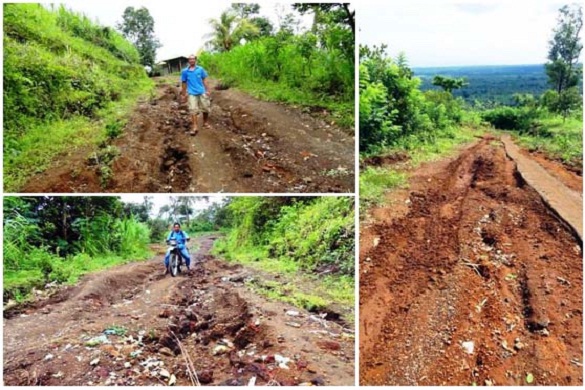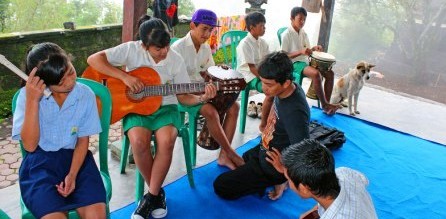

When writing about aid projects words like ‘uplifting’, ‘inspirational’ or ‘downright bloody fantastic’ rarely, if ever, enter the vocabulary of cynical development consultants. That maxim held true until I visited the East Bali Poverty Project (EBPP) located on the remote and inhospitable northeastern slopes of Mount Agung and Mount Abang in Bali. The project is the brainchild of David Booth MBE, a totally dedicated, multi-talented British engineer who dreamed of providing the basic necessities of life to some of the poorest villagers in the whole archipelago and who, in their mountain fastness, seemed to have been forgotten or ignored by the government.
The origins of the EBPP go back to 1998 when David engaged with the people of Desa Ban, a desperately poor, illiterate community of 15,000 people living in abject poverty in 19 remote sub-villages scattered over 7,200 ha of arid, steep land on Mounts Agung and Abang, the former of which erupted in 1963 covering the area in many metres of ash and destroying the forest and life down from its peak. The only access to the outside world was via steep, narrow mountain footpaths and the generations of isolation, combined with poor soils, precipitous slopes and lack of convenient fresh water sources, had created conditions of appalling poverty dominated by serious health issues including probably the highest incidence of goitre in the world (85%), widespread skin diseases such as impetigo, endemic malnutrition and a staggering infant mortality rate of 30% before age one, some ten times the national average.
In the beginning the elders of the community prioritized education for their children as a means of providing a better future. But it was clear that no real progress could be made and the children could not respond properly until the basic health issues were dealt with and access to other villages, many perched on the ridges of geologically recent lava flows, and to the outside world were improved.
The first item under health was to address the key deficiencies of dietary iodine, vitamins and minerals through an ‘awareness’ education programme supported by a steady regimen of iodized oil capsules, sponsored from 2001-2033 inclusive by UNICEF’s Jakarta office, iodized salt, multi-vitamin tablets and a daily glass of fortified milk per child to accompany their nutritious daily meal at school. A system of regular health checks to evaluate and advise on infants’ and children’s nutrition status, provide maternity advice and introduce a regular dentistry programme were also initiated from 2000, but to facilitate these actions, attention had to be paid to providing good access to the villages.
The project set about upgrading existing mountain walking tracks into mountain roads that could accommodate motorcycles and 4-W-D vehicles. The first road was built to the village of Daya from the saddle between Mount Agung and Mount Abang between November 1999 and March 2000; this provided the first road access in history for thousands of people to leave the village and for supplies and knowledge to come in. This involved the local villagers working together under the traditional ‘Gotong Royong’ system of community self-help, surveying new sections of path and providing the labour for widening the path, preparing the sub-base and laying the twin parallel 60 cm wide, 6 cm deep concrete strips under the supervision of David Booth and small his team of local Balinese volunteers. The road-side verges and adjacent slopes were stabilized with amazing vetiver grass. The life of the roads so constructed averages up to ten years on straight and gently inclined sections but only about four years on the bends and very steep sections before major repairs are required. In order to prolong the life of the roads, it is planned to use chicken wire and/or woven local bamboo reinforcement materials on such sections in future.
This privately funded integrated and community-based poverty eradication model is now in its 13th year. The results of directing small donations to specifically targeted objectives selected and managed by the communities themselves are quite staggering. Iodine deficiency and its debilitating effects, goitre and cretinism, have been eradicated; some 800 sanitary rain-water concrete collection tanks each with a 33,000 litre capacity have been built by the local people in schools and villages; piped water has been supplied by gravity feed to many villages from rejuvenated mountain springs; and over 1,000 children have been educated privately in six EBPP hamlet schools from primary through to secondary high school level with a few going onto university. In fact, by 2011, EBPP had their first three university graduates (all young ladies), returning to their villages to work as teachers and help expand the private primary and secondary education programmes in the area since there is still no assistance provided from the local government.
Such remarkable achievements are often in marked contrast to the woeful track record of many of the major donor agencies where the US$ 2.5 million that has been spent over the 13 years of the EBPP, is often expended in one year on administrative charges, illicit fees and expensive consultant reports, that are rarely, if ever, appropriate to real poverty eradication.
Jakarta Expat is launching an appeal for funds for this amazing project that has turned the lives of thousands of villagers from one of utter despair and unimaginable suffering to one of hope for themselves and future generations.
Rp. 75,000 will supply the materials and labour to build one metre of reinforced twin-concrete strip mountain road; the price of two beers in a bar or a haircut, and the project needs 9,000 m to make the 4.5 km-long steep mountain roads to Darmaji and Jatituhu hamlets accessible to 4-W-D vehicles and motorcycles. The Jakarta Expat team and the management of Bugils Bars (Eastern Promise, De Hooi, Cazbar, De Burse) in Jakarta will be involved to raise funds to construct some of the road and we hope our readers will join in to raise funds by sending donations, either by Giro transfer to EBPP bank account or by PayPal, details on our EBPP website “How can I help” Menu:
http://eastbalipovertyproject.org/how-can-i-help/how-to-donate/
If you make a donation, kindly refer to Jakarta Expat. All donations will be acknowledged by a formal e-mail receipt and on the EBPP Donor section of Homepage at www.eastbalipovertyproject.org .
In addition, progress measured in metres of road built will be reported in Jakarta Expat together with a short report and photographs. For companies wishing to donate larger sums, other more formal means of recognition such as a plaque bearing the company logo can be arranged. Formal financial reports on the details of all donated expenditure are available on request to EBPP or to view in their Denpasar office. The 2010 EBPP accounts, audited by Ernst & Young Indonesia, are available on request. Over the next 10 years the Project hopes to build some 20 km of mountain road to connect the remaining sub-villages of Desa Ban to the outside world. Let’s help these villagers move into the fast lane!




